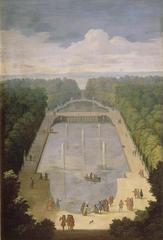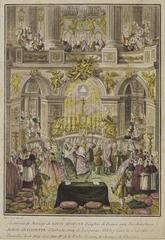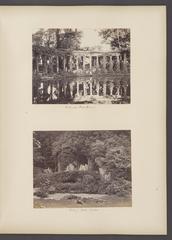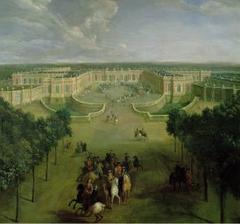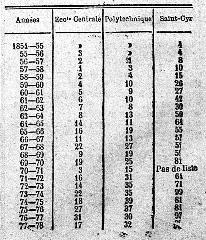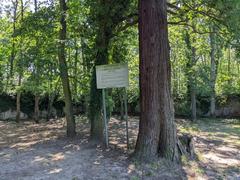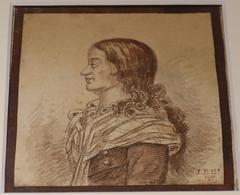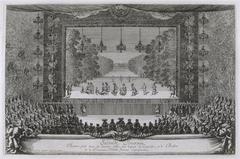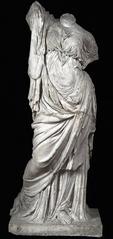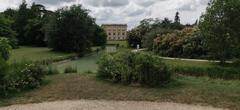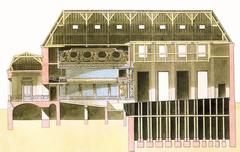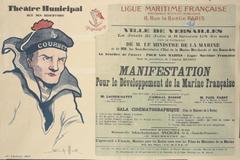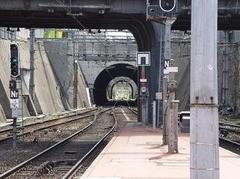
Grotte de Téthys Versailles: Visiting Hours, Tickets, and Historical Guide
Date: 04/07/2025
Introduction
Nestled within the iconic gardens of the Château de Versailles, the Grotte de Téthys stands as an enduring symbol of 17th-century French artistic, mythological, and technological innovation. Though the original structure was demolished in 1684, its legacy persists through preserved sculptures, historical documents, and cutting-edge virtual reality experiences. This comprehensive guide explores the grotto’s rich history, artistic achievements, and modern ways to experience its lost splendor, as well as practical details for visiting Versailles today (deproyart.com, chateauversailles.fr, Princeton University Library).
Table of Contents
- The Grotte de Téthys: Origins and Construction
- Architectural and Artistic Features
- Symbolism and Role in Versailles
- Demolition and Legacy
- Visiting Today: Hours, Tickets, and Access
- Virtual Reality Experience
- Visitor Tips and Accessibility
- FAQ
- Further Reading and Resources
The Grotte de Téthys: Origins and Construction
Commissioned by Louis XIV and constructed between 1665 and 1666, the Grotte de Téthys was designed to evoke the mythological realm of Tethys, the Titaness and mother of rivers and oceans. Situated on the north side of the original château, near the site of today’s Royal Chapel, the grotto was both an artistic marvel and an integral part of Versailles’ advanced water management system. Its roof served as a reservoir, storing water from the Étangs de Clagny and supplying the estate’s fountains through an intricate hydraulic network (Wikipedia, fgintrand.wordpress.com).
Architectural and Artistic Features
Exterior Design
The grotto’s façade, styled as a triumphal arch, symbolized royal authority and grandeur. Sun motifs referencing Louis XIV adorned the central gateway, while bas-reliefs depicting Apollo, tritons, and nereids embellished the attic and spandrels. Isolated as a pavilion within the gardens, the structure’s innovative roof-reservoir was a feat of hydraulic engineering (chateauversailles.fr).
Interior Decoration
The interior of the grotto was conceived as an enchanting undersea world. Walls and vaults were encrusted with shells, rock crystals, and mirrors, creating a shimmering aquatic ambiance. Decorative masks and rocaille motifs, along with mosaics and water features, heightened the magical atmosphere. A hydraulic organ, powered by water pressure, produced music that delighted visitors (Princeton University Library).
Sculptural Masterpieces
Three monumental marble groups formed the artistic centerpiece:
- Apollo Served by the Nymphs: Crafted by François Girardon and Thomas Regnaudin, this group depicts Apollo at rest, attended by five nymphs.
- The Horses of the Sun Groomed by Tritons: Sculpted by Gaspard and Balthazar Marsy (right) and Gilles Guérin (left), these works portray Apollo’s horses being cared for by tritons.
All sculptures were carved from Carrara marble and installed between 1672 and 1675 (chateauversailles.fr).
Symbolism and Role in Versailles
The Grotte de Téthys was deeply symbolic, reinforcing Louis XIV’s identification with Apollo, the Sun God. The grotto’s mythological program, based on Ovid’s Metamorphoses, depicted Apollo resting in Tethys’s marine grotto after his daily journey, mirroring the king’s own retreat. The site functioned as a venue for royal promenades, musical performances, and courtly entertainments, embodying the fusion of art, technology, and power that defined the Versailles estate (sculptures-jardins.chateauversailles.fr).
Demolition and Legacy
In 1684, the construction of Versailles’ North Wing required the demolition of the grotto. However, its major sculptural groups were preserved and relocated to the Bosquet des Bains d’Apollon and the Royal Chapel’s vestibule, where they remain visible today. The Grotte de Téthys has inspired European garden design and remains a touchstone for the Baroque blending of nature, myth, and monarchy (sculptures-jardins.chateauversailles.fr).
Visiting Today: Hours, Tickets, and Access
Where to See the Grotto’s Legacy
- Sculptures: The relocated marble groups are displayed in the Bosquet des Bains d’Apollon in the Versailles gardens and in the Royal Chapel’s vestibule.
- Original Site: The grotto’s former location is now occupied by the North Wing of the château.
Visiting Hours
- Palace: Open Tuesday to Sunday, 9:00 AM – 6:30 PM (last admission at 6:00 PM)
- Gardens: Open daily from 8:00 AM to 8:30 PM (hours vary by season)
Garden sculptures are accessible during garden opening hours (chateauversailles.fr).
Tickets and Admission
- Palace and Gardens Ticket: Starting at €20 for adults.
- Gardens Only: Free access, except on Musical Fountains Show or Musical Gardens days, when a ticket is required.
- VR Experience: Separate ticket (€15 per person), advance booking strongly recommended (Sortir à Paris).
Accessibility
Versailles gardens and the Royal Chapel are largely accessible, with some uneven terrain in outdoor areas. The VR experience space is wheelchair accessible. Always consult the official accessibility guide for current information.
Virtual Reality Experience: “Les Jardins Disparus du Roi Soleil”
To experience the lost wonders of the Grotte de Téthys, visitors can engage with the VR experience “Les Jardins Disparus du Roi Soleil,” available through January 4, 2026. This immersive 25-minute journey uses high-fidelity visuals and audio to recreate the grotto’s appearance and atmosphere with historical accuracy (presse-citron.net, Realité Virtuelle). Suitable for ages 8 and up, the experience is offered in French, English, and Chinese, and is accessible by advance reservation.
Visitor Tips and Accessibility
- Book Tickets Online: Advance booking for both palace entry and the VR experience is highly recommended, especially in peak seasons (chateauversailles.fr).
- Best Times to Visit: Spring and early fall offer pleasant weather and lighter crowds. Visit early in the day for a quieter experience (Wandering Why Traveler).
- Comfort: Wear comfortable shoes and bring water, sunscreen, and a hat for exploring the gardens (Places to Travel).
- Use the Versailles App: Enhance your visit with interactive maps, audio guides, and historical context (The Travel Pockets).
Frequently Asked Questions (FAQ)
Can I visit the original Grotte de Téthys today?
No, the grotto was demolished in 1684. However, its sculptures can be seen in the gardens and Royal Chapel’s vestibule, and an immersive VR experience is available on-site.
How do I access the VR experience?
Book tickets in advance through the official Versailles website. The VR sessions are held multiple times daily.
Is the VR experience suitable for children?
Yes, it is recommended for visitors aged 8 and above.
Are the gardens and VR experience accessible for people with disabilities?
Yes, though some outdoor areas have uneven surfaces. The VR room is wheelchair accessible—contact staff for details.
What are the garden and palace opening hours?
Gardens open at 8:00 AM and the palace at 9:00 AM; closing times vary seasonally.
Further Reading and Resources
- Official Palace of Versailles Website
- Detailed Description of the Grotte de Téthys
- Princeton University Library: Virtual Grotto Experience
Visual Media
 Façade of the Grotte de Téthys with sun motifs symbolizing Louis XIV
Façade of the Grotte de Téthys with sun motifs symbolizing Louis XIV
Alt: “Grotte de Téthys façade at Versailles with sun symbols”
 “Apollo Served by the Nymphs” marble group by François Girardon and Thomas Regnaudin
“Apollo Served by the Nymphs” marble group by François Girardon and Thomas Regnaudin
Alt: “Apollo sculpture in Bosquet des Bains d’Apollon Versailles”
Conclusion
The Grotte de Téthys remains a powerful emblem of Versailles’ artistic, technical, and symbolic legacy. Although the original grotto no longer stands, its relocated sculptures, extensive documentation, and innovative VR reconstructions allow visitors to rediscover its wonders. Whether exploring the gardens, engaging with virtual experiences, or delving into Versailles’ history, the story of the Grotte de Téthys continues to inspire and enchant.
To enrich your visit, download the official Versailles app for guided tours and updates on special events. Stay connected for more insights and tips on exploring the splendors of Versailles.
Sources
- deproyart.com
- chateauversailles.fr
- Princeton University Library
- sculptures-jardins.chateauversailles.fr
- Sortir à Paris
- Cambridge University Press
- presse-citron.net
- Realité Virtuelle
- Wandering Why Traveler
- Places to Travel
- The Travel Pockets






